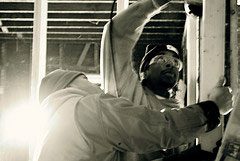
Photo by Whitney Arlene Crispell/PUSH Buffalo, CC BY-NC-ND 2.0
Each year, the Martin Luther King Jr. holiday prompts people to reflect on Dr. King’s life and legacy. By achieving passage of civil rights and voting rights legislation, the actions of King and others compelled a sharp decline in the blatant discrimination and wanton violence that had permeated the nation for generations. However, today, five decades after these and other seminal events altered the course of race relations in America, a level of inequality greater than any time since the recession makes it abundantly clear that much work remains to realize America’s promise of liberty and justice for all.
At the time of his death, Dr. King had shifted the focus of his work from voting rights to economic issues. He had launched the Poor People’s Campaign to seek better jobs, wages, education and other social programs aimed at helping people lift themselves out of poverty. The campaign’s premise resonates deeply today amid entrenched poverty and growing social unrest throughout the United States.
Nationwide, over 350 counties are classified as persistently poor by the federal government. Persistent poverty is defined as a county where the poverty rate has exceeded 20 percent for three decades in a row. Families who live in these distressed areas, along with community development practitioners and others who engage at the local level to address these issues, are painfully familiar with the deteriorating conditions in housing, education, financial services, and health care—the crippling manifestations of this generational poverty.
Persistent poverty exists largely as a rural phenomenon with the greatest concentration of long-term poor counties located across a section of the country that includes Appalachia, the Deep South, the Colonias, and Tribal communities. Interestingly, while persistent poverty can appear homogeneous at the local level, a collective view of those who reside in America’s most impoverished areas conveys a striking portrait of the diversity that is emerging across the nation.
The impact of persistent poverty is also significant in urban neighborhoods. In Memphis, home to three Hope Credit Union branches, 63 of the city’s 221 census tracts have poverty rates that have exceeded 20 percent for three decades. Not surprisingly, the city’s rates of high-cost lending and bankruptcy are among the nation’s highest.
In cities like New York, Ferguson, and Cleveland, tragic deaths of Black Americans stirred smoldering embers of poverty and other volatile conditions that existed long before those communities reached a flashpoint and burst into violence. These events remind us that social unrest and persistent poverty are inextricably connected.
As in the final years of Dr. King’s life, we see once again that people oppressed by structural forces in America’s economic and political systems are in the streets making demands that a nation live up to its promise. And, in some places, these protesters are met with violent police reactions.
Dr. King once said, “If a man doesn’t have a job or an income, he has neither life nor liberty nor the possibility for the pursuit of happiness. He merely exists.” He knew, and we do also, that no American is fully free until he or she has the financial means to live a good life. Yet a Bloomberg report estimates that more than 90 percent of bank branches that closed since the recession have been in low-income census tracts, often giving way to payday lenders, title loan shops, and other high-cost alternatives.
The current state of affairs in impoverished rural areas and inner cities underscores the importance of durable institutions with a deep and lasting community presence to mitigate the harmful effects of poverty. Community Development Financial Institutions (CDFIs) represent the types of organizations that help foster equity and stability. From small-business lending programs that support job creation, to affordable housing development, to community infrastructure expertise that expands access to high quality health care and education, CDFIs are a manifestation of the solutions that Dr. King called for in the Poor People’s Campaign.
By financing entrepreneurs, health care facilities, healthy food retailers, and affordable housing development, and by making other investments that improve lives in low income communities, CDFIs help mitigate the rampant disinvestment that plagues poor areas.
Increasing the capacity of Community Development Financial Institutions that bridge the banking gap in persistent poverty areas is a smart investment. CDFIs connect underserved populations to safe, affordable financial services, which is a proven model for giving people a hand-up on the ladder to economic self-sufficiency.






Comments